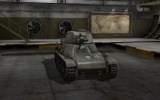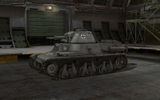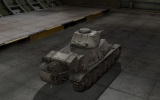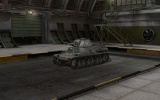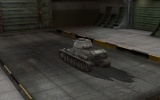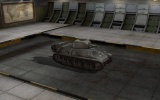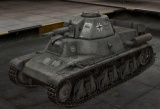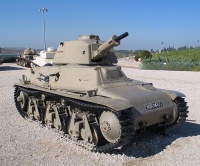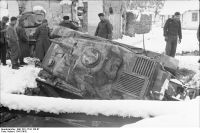Pz.Kpfw. 38H 735 (f)
The PzKpfw 38H735 (f) is a German tier 2 premium Light Tank that used to be purchasable for Gold. Since it is a captured French tank, its play style differs from the other low-tier German tanks. Even so, it is often compared to the Maus because of its low-damage gun, low mobility, and high armor. One may use it as a line breakthrough tank or a durable sniper. All good tanks must have major flaws, and for the Hotchkiss, the flaw is the ability to be "destroyed" by the death of its two crew members. Two hits (possibly even one) directed towards the commander's cupola and turret ring may disable this tank for the remainder of the battle.
- As of February 13, 2012, the PzKpfw 38H735 (f) was removed from the in-game store.
G33 H39 captured/ModulesG33 H39 captured/EquipmentG33 H39 captured/Consumables
{{History|info= The Hotchkiss H39 (a variant of the Hotchkiss H35) was captured and used by Germany as the PzKpfw 38H735 (f).
The Hotchkiss H35, or Char léger modèle 1935 H, was a French light tank developed prior to World War II. Despite having been designed from 1933 as a rather slow, but well-armored, light infantry support tank, the type was initially rejected by the French Infantry because it proved difficult to steer while driving cross-country, and was instead adopted in 1936 by the French Cavalry. In 1938, an improved version was produced with a stronger engine, the Char léger modèle 1935 H modifié 39, that from 1940 was also fitted with a longer, more powerful 37 mm gun. It was intended to make this improved variant the standard light tank, and was to be produced in a number of at least four thousand in order to equip new armored divisions of both the Cavalry and the Infantry. However, due to the defeat of France in June 1940, total production of both subtypes remained limited to about 1200 vehicles. For the remainder of the war, Germany and its allies would use captured Hotchkiss tanks in several modifications.
Description
As the Cavalry wanted an even better top speed, it was decided to bring to fruition experiments already conducted from October 1936 to install a stronger engine. A new prototype was made in 1937, with a 120 hp instead of a 78 hp engine. The hull was enlarged to accommodate it, and the track and the suspension elements were improved, raising the weight to 12.1 tons. This improved variant was faster, with a top speed of 36.5 km/h (22.6 mph), and much easier to drive. Therefore, it was first presented to the Commission d'Expérimentations de l'Infanterie on 31 January, 1939, to see whether the original negative decision could be changed. The commission indeed accepted the type, the Char léger modèle 1935 H modifié 39.
It was decided on 18 February to let it succeed the original version from the four hundred first vehicle onwards, which was just as well, as both in 1937 and 1938 an order had been made for 200 vehicles and production had already started. The total orders of the improved type was thereafter expanded to 900. The factory identifier, however, was the Char léger Hotchkiss modèle 38 série D, its predecessor having been the série B. The designation has caused much confusion; this was still officially the same tank as the "H 35", only in a later variant. However, even at the time, many began to refer to it as the 38 H or the 39 H.
The new subtype differed from the original one in having a raised and more angular engine deck (In later production, vehicles had crosswise instead of longitudinal ventilation slits on the right side.), road-range decreased to 120 km, closed idler wheels, tracks two centimetres wider at 27 cm, metal instead of rubber wheel treads, a silencer directed to the back, and larger, more reliable and effective ventilators.
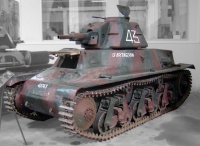
In early 1940, a modernisation program was initiated. Aside from the fitting of episcopes, tails, and some radio sets, this included the gradual introduction of a longer L/35 37 mm SA38 gun that had a much improved anti-tank capacity (30 mm penetration at 1000 m). About 350 vehicles were (re)built with the better gun, among them about fifty "H 35"s.[1] The new gun became standard in the production lines in April. Before that change, the available new guns had, from January 1940, gradually been fitted to the tanks of platoon, company, and battalion commanders; about half of the commander vehicles in Hotchkiss units were so modified. It had been intended to fit the longer gun to all vehicles during the second half of 1940.
After the war, it was for a time erroneously assumed that "H 38" was the official name of the tank with the new engine, but without the new gun: "H 39" was the name of the type that had both major improvements. These mistakes are still common in many secondary literature. The "H 38" was, in fact, identical to the "H 39", and it is only correct to refer to the latter in an informal sense. Parallel to the development of an R 40, consideration was given, for a time, to the creation of an "H 40" by adopting the improved AMX suspension of the other vehicle. In the end, this option was rejected.
Operational history
In April 1940, the 342e CACC was sent to Norway after the German invasion of that country, having first been intended to form part of an expeditionary force to assist Finland in the Winter War. This autonomous company, equipped with fifteen "H 39"s, all with short guns, fought at Narvik, after having landed on 7 May. After the temporary liberation of that city, the twelve remaining vehicles were withdrawn to Britain on 8 June, where they joined the Free French, forming the 1e Compagnie de Chars de Combat de la France Libre. In 1940 and 1941, this 1e CCC fought against Vichy-troops in Gabon, and later in Syria.
About 550 tanks were captured and used by the Germans as the Panzerkampfwagen 35H 734(f) or Panzerkampfwagen 38H 735(f). Most were used for occupation duty, but the independent 211e Panzerabteilung was deployed in Finland during Operation Barbarossa. Additional vehicles were sent to Finland as part of the independent Panzerkampfwagenzüge (tank platoons) 217, 218, and 219, which were attached to the 20th Mountain Army in February 1942[3]. The platoons were the same as those of Panzerabteilung 211, consisting of one SOMUA S35 and four Hotchkiss tanks.
Like the French themselves, the Germans made no clear distinction between a "H 38" and a "H 39"
